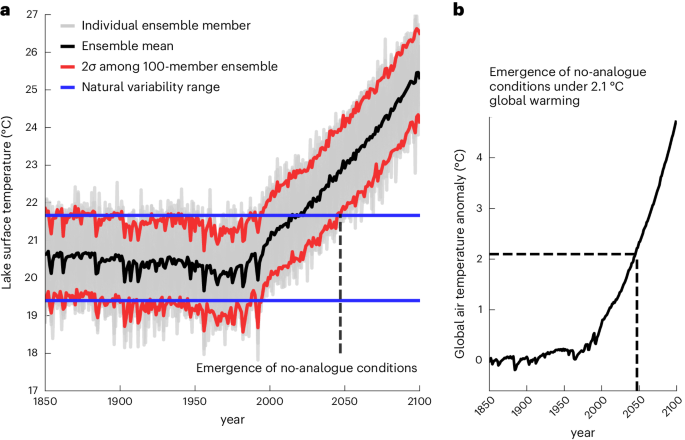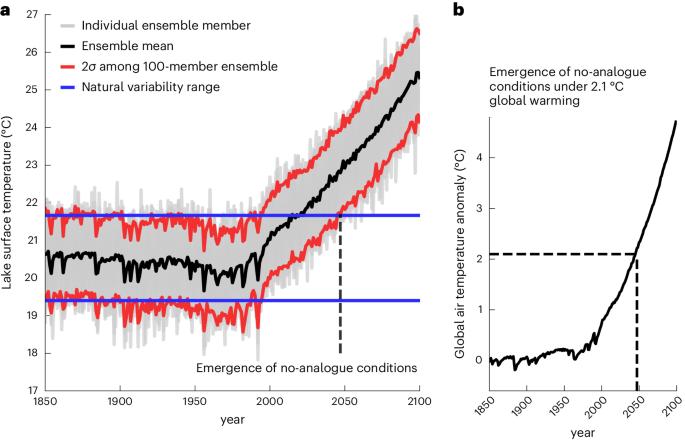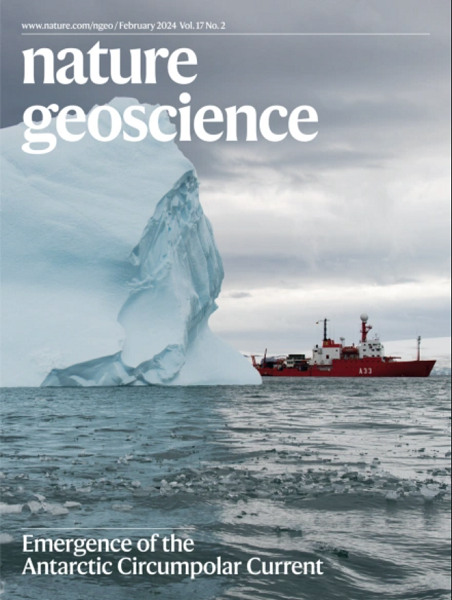Emergence of lake conditions that exceed natural temperature variability
IF 15.7
1区 地球科学
Q1 GEOSCIENCES, MULTIDISCIPLINARY
引用次数: 0
Abstract
Lake surface temperatures are projected to increase under climate change, which could trigger shifts in the future distribution of thermally sensitive aquatic species. Of particular concern for lake ecosystems are when temperatures increase outside the range of natural variability, without analogue either today or in the past. However, our knowledge of when such no-analogue conditions will appear remains uncertain. Here, using daily outputs from a large ensemble of SSP3-7.0 Earth system model projections, we show that these conditions will emerge at the surface of many northern lakes under a global warming of 4.0 °C above pre-industrial conditions. No-analogue conditions will occur sooner, under 2.4 °C of warming, at lower latitudes, primarily due to a weaker range of natural variability, which increases the likelihood of the upper natural limit of lake temperature being exceeded. Similar patterns are also projected in subsurface water, with no-analogue conditions occurring first at low latitudes and occurring last, if at all, at higher latitudes. Our study suggests that global warming will induce changes across the water column, particularly at low latitudes, leading to the emergence of unparalleled climates with no modern counterparts, probably affecting their habitability and leading to rearrangements of freshwater habitats this century. Earth system models project that lake temperatures will warm beyond the range of natural variability to which aquatic ecosystems are adapted in the coming decades, with conditions exceeding natural analogues sooner at lower latitudes.


出现超过自然温度变化的湖泊状况
在气候变化的影响下,湖泊表面温度预计会升高,这可能会导致对温度敏感的水生物种的未来分布发生变化。对于湖泊生态系统来说,尤其值得关注的是,当温度上升超出自然变化范围时,无论是现在还是过去,都不会出现类似情况。然而,我们对这种无类比条件何时出现的了解仍不确定。在这里,我们利用 SSP3-7.0 地球系统模型预测的大型集合的日输出结果,表明在全球变暖比工业化前温度高 4.0 °C 的情况下,北方许多湖泊的表面将出现这种情况。在全球变暖 2.4 ℃ 的情况下,低纬度地区将更快出现类似情况,这主要是由于自然变率范围较小,从而增加了湖泊温度超过自然上限的可能性。类似的模式也会出现在地下水中,低纬度地区会首先出现无模拟条件,而高纬度地区则会最后出现(如果有的话)。我们的研究表明,全球变暖将引起整个水体的变化,尤其是在低纬度地区,从而导致出现无与伦比的现代气候,这可能会影响它们的可居住性,并导致本世纪淡水栖息地的重新布局。
本文章由计算机程序翻译,如有差异,请以英文原文为准。
求助全文
约1分钟内获得全文
求助全文
来源期刊

Nature Geoscience
地学-地球科学综合
CiteScore
26.70
自引率
1.60%
发文量
187
审稿时长
3.3 months
期刊介绍:
Nature Geoscience is a monthly interdisciplinary journal that gathers top-tier research spanning Earth Sciences and related fields.
The journal covers all geoscience disciplines, including fieldwork, modeling, and theoretical studies.
Topics include atmospheric science, biogeochemistry, climate science, geobiology, geochemistry, geoinformatics, remote sensing, geology, geomagnetism, paleomagnetism, geomorphology, geophysics, glaciology, hydrology, limnology, mineralogy, oceanography, paleontology, paleoclimatology, paleoceanography, petrology, planetary science, seismology, space physics, tectonics, and volcanology.
Nature Geoscience upholds its commitment to publishing significant, high-quality Earth Sciences research through fair, rapid, and rigorous peer review, overseen by a team of full-time professional editors.
 求助内容:
求助内容: 应助结果提醒方式:
应助结果提醒方式:


